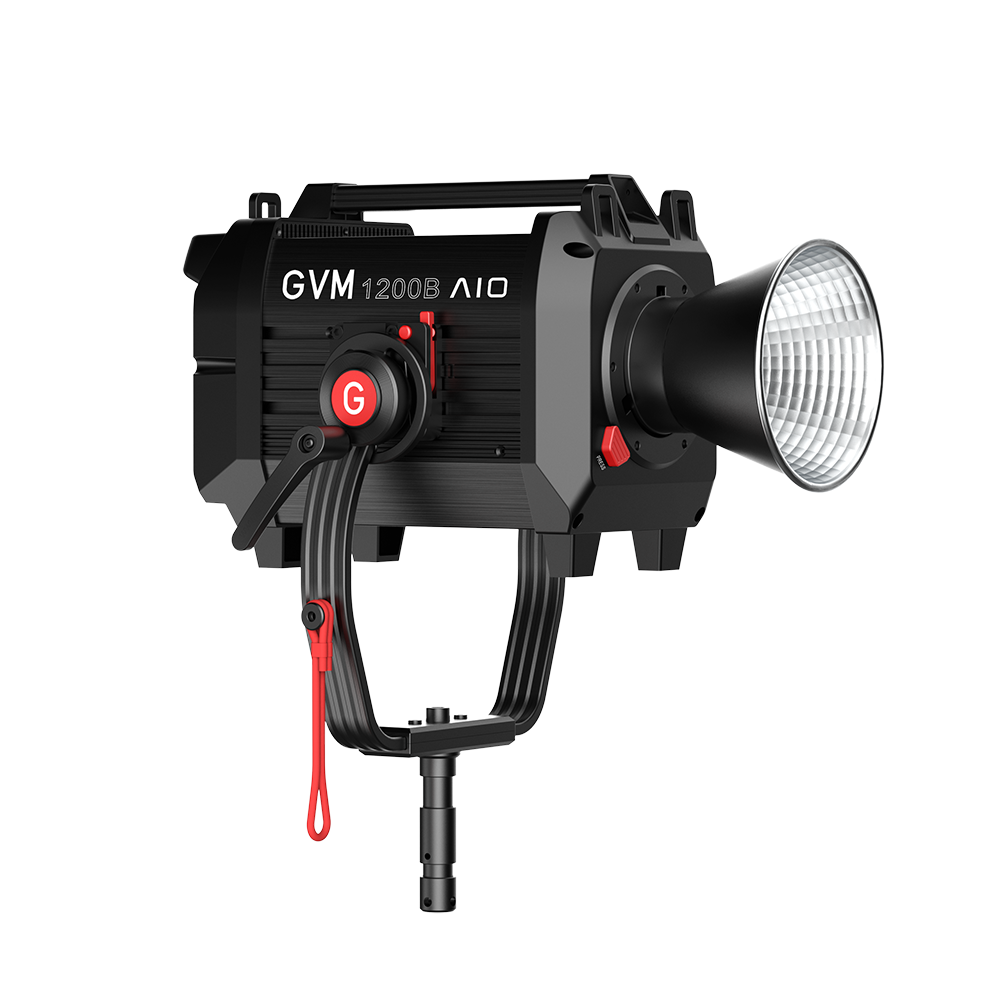Alright folks, let’s talk movie studio lights. Whether you’re a seasoned film lighting pro, a budding video blogger, or just starting your journey in the visual world, you’ve likely discovered that lighting is the make-or-break element of any production. And let’s be honest, navigating the sheer number of choices can feel daunting.
That’s where this guide comes in. Consider this your comprehensive resource to making informed decisions and building a lighting setup that elevates your work, regardless of your budget or experience. We’ll be looking at how different types of lights fit into various setups, and what characteristics to consider as you’re evaluating your options.
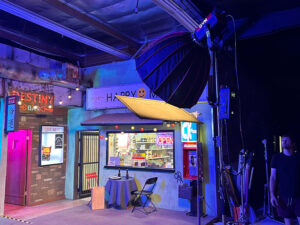
Speaking of great movie studio lights options, we highly recommend the GVM SD650B – a versatile light perfect for a variety of filmmaking scenarios. We’ll now dive deep into the specific details about the things you should be paying attention to when buying Film Studio Lights, so that you can make the right decision for your specific project.
Understanding the Core Types of Movie Studio Lights: Your Toolkit
Let’s start by breaking down the key players in the “movie studio lights” game. Each type has its strengths and weaknesses, and understanding these will guide your purchase decisions.
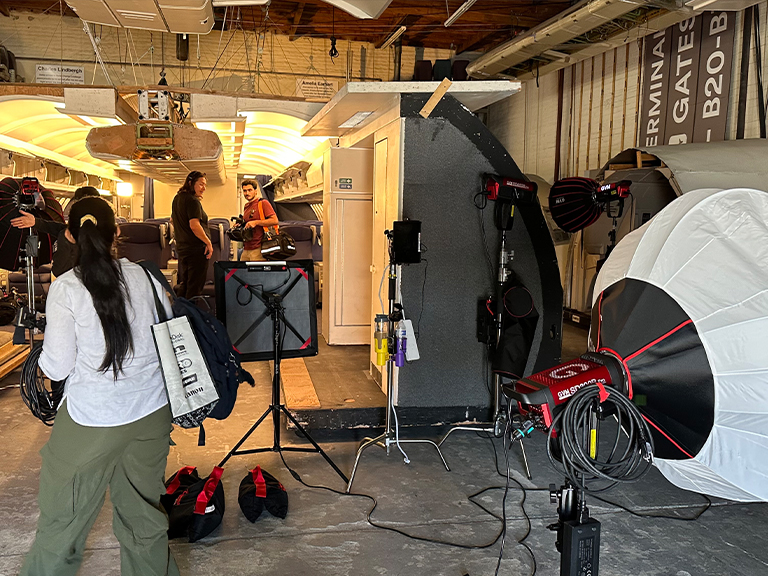
- LED Panels: These are rapidly becoming the workhorses of modern film and video sets. LED panels are celebrated for their energy efficiency – a significant advantage over traditional lights – their color accuracy, versatility, and relatively low heat output. You’ll find variations like soft panels (providing diffused, even light), bi-color panels (adjustable color temperature), and RGB panels (offering a vast spectrum of colors for creative effects. Use these for general illumination, interviews, or as a soft fill light. When considering LED panels, think about the size of your typical shooting space and the flexibility you need in terms of color control. Consider features like robust build quality and intuitive controls.
- Fresnel Lights: These are your classic “movie studio lights,” iconic for their distinctive lens and powerful, focusable beam. The Fresnel lens allows you to adjust the light’s spread, from a tight, intense spotlight to a wider, softer wash. Fresnels are fantastic for creating dramatic shadows, acting as a strong key light, and sculpting your subject. If you’re aiming for a more cinematic look with defined shadows, a Fresnel is a valuable tool. Look for models with smooth focusing mechanisms and well-engineered heat dissipation.
- COB (Chip-on-Board) Lights: COB technology represents a significant advancement in LED design. It essentially concentrates a large number of LEDs into a single, powerful source. This translates to increased efficiency, higher light output for a given size, and generally excellent color accuracy. COB lights are often used as powerful key lights and are particularly effective when combined with modifiers like softboxes or umbrellas to shape the light. Their punch and efficiency make them ideal for situations where you need a lot of light from a relatively compact source.
- Softboxes & Diffusers: Not lights themselves, but crucial tools for shaping and controlling the light output of your “movie studio lights.” Softboxes attach to your lights, creating a larger, diffused light source that softens shadows and reduces harshness. They come in various shapes and sizes – rectangular, octagonal, square, and strip – each offering a slightly different quality of light. Diffusers, typically made of translucent fabric, are placed in front of a light to achieve a similar effect. Learning to use softboxes and diffusers effectively is key to achieving flattering and natural-looking results.
- Specialty Lights: There’s a category of lights that serve more specific purposes. Practical Lights are those that exist in the scene and are visible in frame – lamps, chandeliers, etc. – and often contribute to the overall lighting design. Ring Lights are popular in the vlogging and beauty communities, offering a soft, even illumination perfect for close-up shots. Finally, Gobo Projectors allow you to project patterns and textures of light onto your scene, adding visual interest and complexity.
Decoding the Key Specifications of Movie Studio Lights: What the Numbers Mean
| Parameter | Value | Description |
|---|---|---|
| Wattage | 650W | Indicates the power consumption of the light. |
| Color Temperature | 2700K – 6800K | Adjustable range from warm to cool light. Allows for versatile scene lighting. |
| CRI | 97+ | High color rendering index for accurate color reproduction. |
| TLCI | 97+ | High Television Lighting Consistency Index for accurate color reproduction in video. |
| CQS | 94+ | Color Quality Scale |
| SSI | 72 | Spectral Similarity Index |
| Lux (at 1 meter) | 116,000 Lux | Maximum light intensity at 1 meter. |
| Brightness Increase with Fresnel | 450% – 960% | Brightness increased with GVM-F60 Fresnel attachment. |
| Dimming | 0.1% – 100% | Precise dimming control for fine-tuning light intensity. |
| Beam Angle | N/A (Adjustable with modifiers) | Beam angle depends on modifiers used with the Bowens Mount. |
Don’t let the technical jargon intimidate you. Understanding the key specifications of “movie studio lights” will empower you to compare different options and choose the right ones for your needs.
- Wattage: This indicates the power consumption of the light. While higher wattage often means higher light output, it’s not the whole story. LED technology is far more efficient than traditional lighting, so a lower wattage LED can often produce more light than a higher wattage incandescent bulb. Think about lumens (the measure of light output) rather than solely focusing on wattage.
- Color Temperature (Kelvin): We touched on this earlier. Lower Kelvin values (2700-3200K) produce warm, yellowish light, while higher values (5500-6500K) produce cool, bluish light. Choosing the right color temperature is crucial for creating the desired mood. Bi-color lights offer the flexibility to adjust the color temperature, making them incredibly versatile.
- Color Rendering Index (CRI) and TLCI: These are measures of how accurately a light renders colors. A higher CRI/TLCI (ideally 95 or above) means more accurate color reproduction in your footage. This is especially important for professional video and film work, where color accuracy is paramount. Be sure to check these specs before making a purchase.
- Beam Angle: This describes the spread of light emitted from the light source. A narrow beam angle creates a concentrated spotlight effect, while a wider beam angle provides a more diffused wash of light. Some “movie studio lights” offer adjustable beam angles, providing even greater control.
- Lux and Foot-Candles: These are units of measurement for light intensity. Lux (lumens per square meter) is the standard metric unit, while foot-candles (lumens per square foot) is more common in the US. Knowing these measurements allows you to compare the brightness of different lights objectively.
- Dimming Capabilities: This is essential for fine-tuning the light intensity to achieve the perfect look. Look for stepless dimming for smooth, gradual adjustments. Accurate and consistent dimming across the entire range is a hallmark of quality lighting.
Budgeting for Your Movie Studio Lights: Gear for Every Level
Let’s face it, budget is a major factor for most of us. Fortunately, you can achieve excellent results at any price point with the right knowledge and choices. It’s about prioritizing your needs and investing wisely. Consider what features are most important for your typical shooting scenarios.
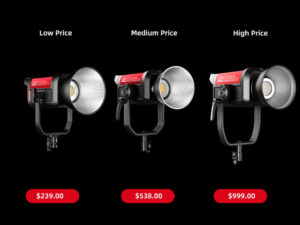
- Entry-Level (Under $500): This range is perfect for beginners and video bloggers starting out. Focus on LED panels and inexpensive softboxes. Don’t be afraid to start small and build your kit over time. Prioritize versatility and durability.
- Mid-Range ($500 – $2000): This is where you can start investing in higher-quality “movie studio lights” that offer better performance, features, and durability. Consider investing in versatile lighting options that can adapt to a variety of shooting situations. Look for features like bi-color functionality, higher CRI ratings, and more robust construction.
- High-End (Over $2000): This is the realm of professional-grade lighting solutions designed for demanding productions and large studios. At this level, you’re paying for top-tier performance, reliability, and advanced features. Look for features like advanced wireless control, exceptional color accuracy, and superior build quality.
The budget is always determined by the following output, feature set, and build quality. Think carefully about your current needs, but also about what kind of projects you envision yourself tackling in the future. Invest in quality lights that will stand the test of time.
Powering Your Lights: Keeping the Set Lit
Understanding how to power your “movie studio lights” safely and efficiently is crucial.
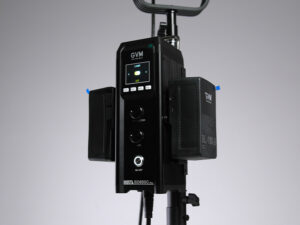
- AC Power: Standard wall outlets are the most common power source, but be mindful of their limitations. Avoid overloading circuits, and use power strips with surge protectors to protect your equipment. Understanding Amps and Voltage is essential for safe power distribution.
- Battery Power: Battery power offers unparalleled portability and convenience, especially for location shooting. V-Mount and Gold Mount batteries are the industry standard, providing reliable power for extended periods. Some lighting systems offer excellent battery solutions that seamlessly integrate with their lights for optimal performance and run time.
- Power Distribution: On larger sets, proper power distribution is paramount for safety and efficiency. Use dedicated power distribution boxes to manage multiple lights and prevent overloads.
Accessories and Modifiers: Shaping the Light
Accessories and modifiers give you even more control over your “movie studio lights,” allowing you to sculpt and refine the light to achieve your desired look.
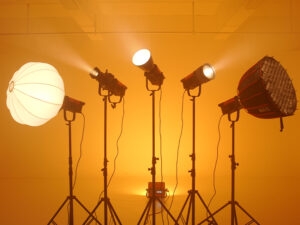
- Barn Doors: These attach to the front of your lights, allowing you to shape the beam and control light spill.
- Gels: These are colored filters that change the color temperature of your light or add creative color effects. Use high-quality gels to ensure accurate color rendition.
- Scrims: Used to reduce light intensity without altering the color temperature.
- Flags: Used to block light and create shadows.
- Reflectors: Bounce light into shadows and fill the area.
- Gobos: metal cutouts that project shapes and patterns of light.
Creating Lighting Setups: Practical Examples

Interview Lighting: The classic three-point lighting setup remains a gold standard for interviews. Focus on creating a flattering and natural look. Pay close attention to shadow placement and intensity.
Product Lighting: Even, diffused lighting is key for showcasing products effectively. Pay attention to reflections and highlights. Use a light tent to create a perfectly diffused environment.
Narrative Scene Lighting: Use color temperature and shadows to set the mood and tell the story visually. Experiment with different lighting ratios to create different emotional effects.
Live Streaming/Vlogging Lighting: Look for even, flattering illumination. A simple two-light setup can often be more effective than a single light source. Pay attention to color temperature to ensure accurate skin tones.
Maintenance and Safety: Keeping Your Lights in Top Condition
Proper maintenance and safety practices will extend the lifespan of your “movie studio lights” and prevent accidents.
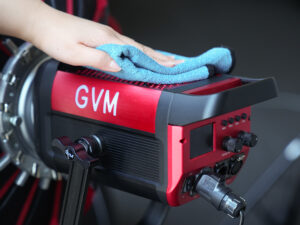
- Cleaning and Storage: Dust and dirt can damage your lights and reduce their performance. Use a soft cloth to clean your lights regularly. Store your lights in a cool, dry place.
- Troubleshooting Common Problems: Familiarize yourself with common issues and their solutions. Knowing how to troubleshoot basic lighting problems can save you time and money on set.
- Safety Precautions: Electricity and heat can be dangerous. Always follow safety guidelines. Never leave lights unattended and always use proper safety cables. Regular safety checks are essential.
Movie Studio Lights: Future Trends in Film Lighting Technology
Film lighting is constantly evolving. We can expect to see continued advancements in LED technology, greater adoption of wireless control and smart lighting systems, and the rise of virtual production, which demands highly sophisticated and accurate lighting solutions. Pay attention to innovations in color science and remote control capabilities.
Conclusion:
Choosing the right “movie studio lights” doesn’t have to be a daunting task. By understanding the different types of lights, their specifications, and how to use them effectively, you can build a lighting setup that enhances your visuals and helps you tell your stories. Take the time to research your options and experiment with different lighting techniques to find what works best for you. Remember, the best lighting is the lighting that serves your creative vision. Good lighting is a skill honed over time, so keep learning and keep creating.
Now, go out there, experiment, and light up the world!


